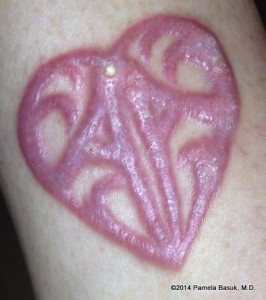Allergic reaction to chemicals in a bandage
Allergic Contact Dermatitis (ACD) is an eruption on the skin that develops when someone comes in contact with a substance called an allergen. An allergen is a substance that is harmless to most people but causes a rash on those who are susceptible. The allergic rash may not develop on first exposure but may occur only after years of exposure to the allergen. Most contact allergens are weak and repeated exposures are needed before an individual becomes sensitive. Poison ivy is considered a strong contact allergen and only requires two exposures for the rash to develop. Once allergic to a particular substance, a person will usually remain allergic for life. Allergic skin rashes lead to 5.7 million-doctor visits annually.
What ACD looks like
These contact allergens can cause a skin rash which is itchy, red, swollen,and can blister. Sometimes the skin can be dry and scaly. It can be located anywhere on the skin: the location of the rash helps to determine the source of the allergy because it develops where the allergen contacts the skin. For example, a rash on the neck or wrist may suggest an allergy to the metal (nickel) found in a necklace or wristwatch. Rashes on both feet may be due to chemicals found in the leather or rubber of shoes. In severe cases, the rash may extend beyond the point of contact and appear elsewhere on the body.
Raised skin – Allergic reaction to red dye in tattoo
Methods of exposure
- Intentional exposure: when a person willingly applies a product to their skin.
- Touching the surface of an object that contains the allergen.
- Transferring the allergen from a person’s hands to another skin body part that is also sensitive to the chemical. Common examples of this: when someone transfers nailpolish to the eyelid or when someone touches poison ivy and then touches another area of the skin.
- Airborne: when the air transfers the chemical from an environmental source to the skin.
What Causes ACD
There are many causes of ACD. Some of the most common culprits are:
- Nickel: contained in jewelry, metals, and metal-plated objects.
- Rubber: black rubber products, medical gloves, clothing seams, shoes.
- Chromates: cutting oils, cement, leather, some matches, paints, anti-rust products.
- Hair dyes: p-phenylenediamine found in hair dyes, dyed textiles, cosmetics, ink.
- Neomycin: topcial antibiotics.
- Plants: poison ivy, poison oak, poison sumac.
- Fragrances: cosmetics, flavorings, scented household products.
- Preservatives: in cosmetics and skin care products, household cleanters, industrial products.
Clinical Photos of Different Types of ACD
A reaction to glue for artificial nails

Reaction to chemicals in shoes
Allergic reaction to contact with poison ivy; the poison ivy leaves are somewhat shiny and have smooth, not serrated edges.
Testing for ACD
- Sometimes the cause of the allergic rash cannot be determined by history or physical examination. A series of patch tests may reveal the source. Patch tests are a safe and effective way to try to diagnose what causes the skin allergy. The patch test kit includes a series of strips that are applied to the skin, each of which contains a small amount of a particular chemical. A positive allergy test is revealed by a red, flat or raised spot at the patch test site, possibly with blisters. These patches are removed after two days and then re-read two days after that to determine if the patient has an allergy to any of the chemicals in the test. Other allergens, not included in the patch test, may be tested with scratch skin tests.
Treatment for ACD
The simplest way to treat an allergic rash is to avoid the chemical that is causing the reaction. In addition, an application of a topical steroid preparations and oral antihistamines may be prescribed. Extensive blistering, common with poison ivy, for example, may develop: a topical soak regimen may be necessary treatment. With severe rashes, oral or injectable medications may be necessary.
- In nickel sensitive patients, one must avoid nickel-containing jewelry: only nickel-free earrings should be worn. Clothing fasteners such as buckles, buttons, snaps on jeans, metal clips, and zippers can cause dermatitis. Jewelry must be nickel free, and zippers can be changed to nylon accessories.
- For those allergic to rubber, one may need to wear latex-free gloves such as vinyl or other synthetic material. Undergarments may have rubber fasteners or edges which must be avoided. Adhesives in shoes may also cause problems which must be avoided.
Chromates found in cement, leather, paints, and anti-rust products may need to be avoided. Vegetable-tanned footwear can be used as an alternative to shoes tanned with chromates. - Hair dyes containg paraphenylene-diamine (PPD) may be allergenic and can be substituted with temporary dyes or rinses.
- Neomycin is a common allergen found in antibiotic creams, ointment, lotions, ear drops, and eye drops. This product can be easily avoided by reviewing the ingredients on many over the counter products.
- Poison ivy dermatitis also includes reactions to poison oak and poison sumac. Patients allergic to poison ivy and its relatives may need to avoid furniture lacquer, mango rinds, and cashew shells.
- Fragrances are included in many cosmetic products. People allergic to certain fragrances must find “fragrance-free products”. “Unscented” products may still have a masking fragrance used to cover up the odor of the other chemical ingredients.
- Preservatives are found in many cosmetic products to retard spoiling. There are very few truly preservative-free products; some preservatives can cause an allergic reaction.
The most important rules to follow are:
- Know your allergen: patch testing may be necessary.
- Avoid the allergen that is causing the reaction and any chemicals that may cross-react with the allergen.
- Find and use products that do not contain the chemical which causes the skin reaction.
- Apply medications prescribed by a dermatologist to help clear the eruption.




